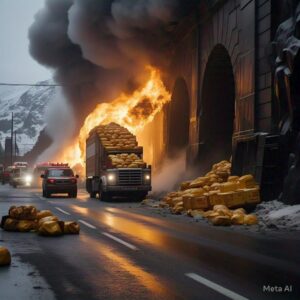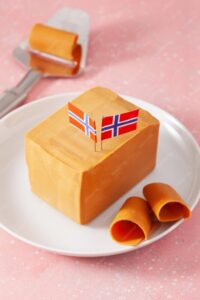Brunost Fun Facts
* Every year, Norwegians eat 12,000 tons of brunost, which means an average of more than 6 pounds [almost 3 kg] per person.
* Unlike most cheeses, brunost is made from whey (the liquid left after milk has been curdled and strained) instead of milk.
* Brunost has a unique brown color, which is a result of the caramelization of the milk sugars during the production process.
* High in Fat: Brunost is rich in fat, which contributes to its creamy texture and satisfying taste.
CHad’s VIdeos
Check out some of Norsk Storyteller Chad Filley’s Videos.

“Cheese Inferno: The Unlikely Fire that Tore Through Norway’s Brunost Tunnel”
In January 2013, a seemingly innocent truckload of brunost, a beloved Norwegian brown cheese, sparked an incident that no one could have predicted. The truck, carrying approximately 27 tons of the cheese, was making its way through the Brattli Tunnel in northern Norway when a fire broke out. What followed was an extraordinary and unexpected event, which would cause widespread disruption and leave the world questioning the flammability of this traditional dairy product.
“As it turns out, when brunost catches fire, it burns nearly as intensely as gasoline, a fact that became painfully evident during this fire.”
Brunost is a rich, caramel-colored cheese made from whey, fat, and sugar, and it’s an essential part of Norwegi an cuisine. But few could have imagined that its high fat and sugar content would make it highly combustible. As it turns out, when brunost catches fire, it burns nearly as intensely as gasoline, a fact that became painfully evident during this fire. The flames quickly spread, feeding off the cheese’s rich composition, and within hours, the truck and its contents were engulfed in a raging inferno.
an cuisine. But few could have imagined that its high fat and sugar content would make it highly combustible. As it turns out, when brunost catches fire, it burns nearly as intensely as gasoline, a fact that became painfully evident during this fire. The flames quickly spread, feeding off the cheese’s rich composition, and within hours, the truck and its contents were engulfed in a raging inferno.
The fire would burn for five days, causing significant damage to the Brattli Tunnel and halting traffic for weeks. As the blaze raged on, the tunnel filled with thick, toxic smoke, making it difficult for firefighters to approach the scene. The intense heat and gases released from the burning cheese made it one of the most challenging fires to control. The authorities struggled with the prolonged firefighting efforts, as the cheese’s sugar and fat components created a perfect storm for an unrelenting burn. 
Fortunately, no one was injured in the incident. The driver of the truck, who had been near one of the tunnel’s exits, managed to evacuate safely before the flames could reach him. Still, the aftermath of the fire caused significant disruption to the region, as the tunnel’s closure forced travelers to take lengthy detours. The Brunost Tunnel fire became a national talking point, with the quirky nature of the cause only adding to its intrigue.
This unusual event highlighted the importance of understanding the properties of materials being transported, especially when they defy conventional expectations. While the fire may have seemed like an odd anomaly at first, it revealed a larger truth: certain materials—like food products with high fat content—can burn unexpectedly when exposed to heat. The brunost fire underscored the need for better preparation and awareness when transporting such materials, particularly in confined spaces like tunnels, where the risks are compounded.
“I knew that cheese can clog arteries and a digestive tract, but who knew it could clog a traffic tunnel?” Norsk Storyteller Chad Filley
The Brunost Tunnel fire may have been an unanticipated disaster, but it also became a strange, unforgettable chapter in Norway’s history.

